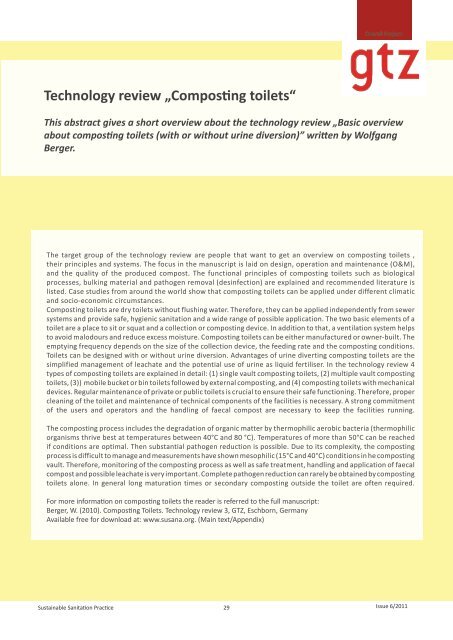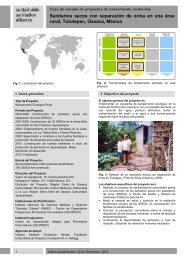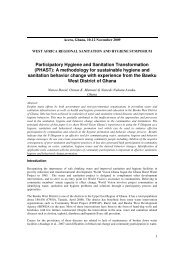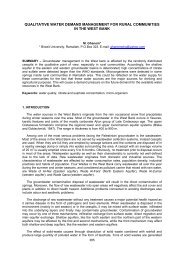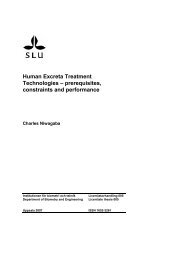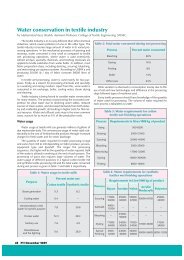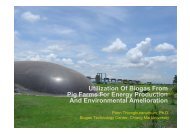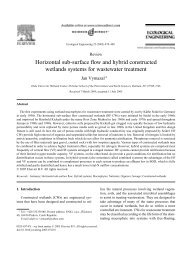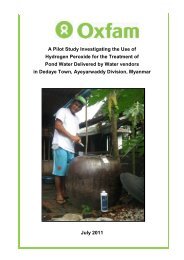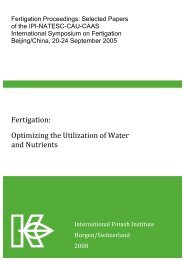Experiences with urine diverting dry toilets - EcoSan Club
Experiences with urine diverting dry toilets - EcoSan Club
Experiences with urine diverting dry toilets - EcoSan Club
Create successful ePaper yourself
Turn your PDF publications into a flip-book with our unique Google optimized e-Paper software.
Technology review „Composting <strong>toilets</strong>“<br />
Sustainable Sanitation Practice<br />
29<br />
<br />
<br />
<br />
Overall Project:<br />
This abstract gives a short overview about the technology review „Basic overview<br />
about composting <strong>toilets</strong> (<strong>with</strong> or <strong>with</strong>out <strong>urine</strong> diversion)” written by Wolfgang<br />
Berger.<br />
The target group of the technology review are people that want to get an overview on composting <strong>toilets</strong> ,<br />
their principles and systems. The focus in the manuscript is laid on design, operation and maintenance (O&M),<br />
and the quality of the produced compost. The functional principles of composting <strong>toilets</strong> such as biological<br />
processes, bulking material and pathogen removal (desinfection) are explained and recommended literature is<br />
listed. Case studies from around the world show that composting <strong>toilets</strong> can be applied under different climatic<br />
and socio-economic circumstances.<br />
Composting <strong>toilets</strong> are <strong>dry</strong> <strong>toilets</strong> <strong>with</strong>out flushing water. Therefore, they can be applied independently from sewer<br />
systems and provide safe, hygienic sanitation and a wide range of possible application. The two basic elements of a<br />
toilet are a place to sit or squat and a collection or composting device. In addition to that, a ventilation system helps<br />
to avoid malodours and reduce excess moisture. Composting <strong>toilets</strong> can be either manufactured or owner-built. The<br />
emptying frequency depends on the size of the collection device, the feeding rate and the composting conditions.<br />
Toilets can be designed <strong>with</strong> or <strong>with</strong>out <strong>urine</strong> diversion. Advantages of <strong>urine</strong> <strong>diverting</strong> composting <strong>toilets</strong> are the<br />
simplified management of leachate and the potential use of <strong>urine</strong> as liquid fertiliser. In the technology review 4<br />
types of composting <strong>toilets</strong> are explained in detail: (1) single vault composting <strong>toilets</strong>, (2) multiple vault composting<br />
<strong>toilets</strong>, (3)) mobile bucket or bin <strong>toilets</strong> followed by external composting, and (4) composting <strong>toilets</strong> <strong>with</strong> mechanical<br />
devices. Regular maintenance of private or public <strong>toilets</strong> is crucial to ensure their safe functioning. Therefore, proper<br />
cleaning of the toilet and maintenance of technical components of the facilities is necessary. A strong commitment<br />
of the users and operators and the handling of faecal compost are necessary to keep the facilities running.<br />
The composting process includes the degradation of organic matter by thermophilic aerobic bacteria (thermophilic<br />
organisms thrive best at temperatures between 40°C and 80 °C). Temperatures of more than 50°C can be reached<br />
if conditions are optimal. Then substantial pathogen reduction is possible. Due to its complexity, the composting<br />
process is difficult to manage and measurements have shown mesophilic (15°C and 40°C) conditions in he composting<br />
vault. Therefore, monitoring of the composting process as well as safe treatment, handling and application of faecal<br />
compost and possible leachate is very important. Complete pathogen reduction can rarely be obtained by composting<br />
<strong>toilets</strong> alone. In general long maturation times or secondary composting outside the toilet are often required.<br />
For more information on composting <strong>toilets</strong> the reader is referred to the full manuscript:<br />
Berger, W. (2010). Composting Toilets. Technology review 3, GTZ, Eschborn, Germany<br />
Available free for download at: www.susana.org. (Main text/Appendix)<br />
Issue 6/2011


